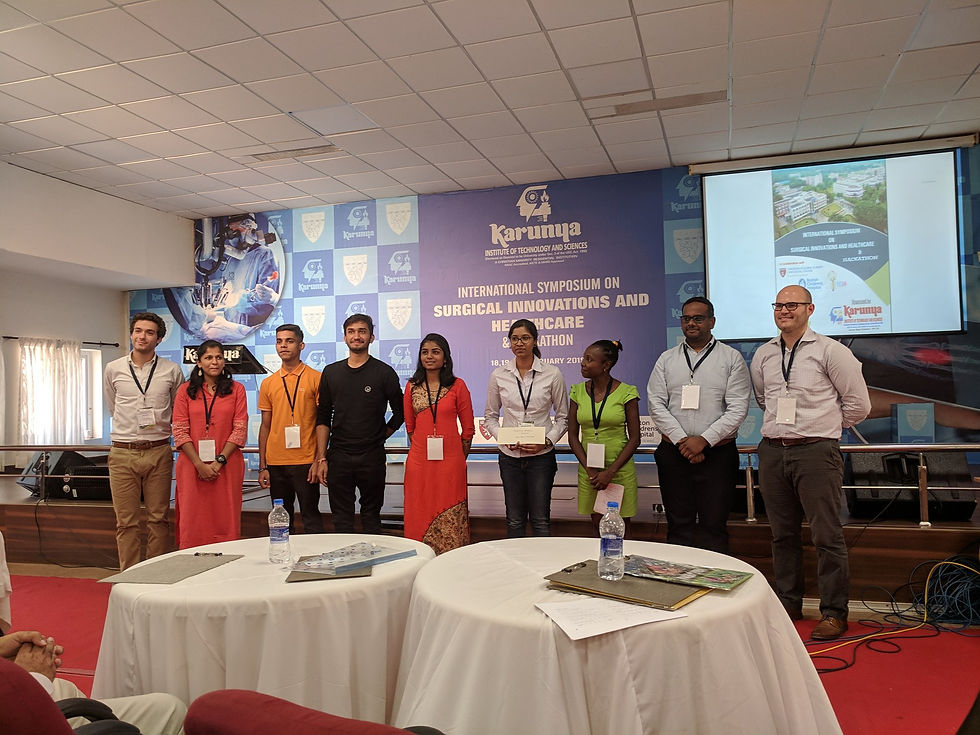Finding surgical innovations for rural surgery in India
- Desmond T. Jumbam

- Mar 28, 2019
- 4 min read
A few weeks ago, I had the opportunity to attend my first global surgery hackathon and it was truly inspiring. Over two and a half days, students from Karunya Institute of Technology and Sciences (KITS) and neighboring academic institutions in rural India attended a global surgery symposium and hackathon hosted by KITS in partnership with the Program in Global Surgery and Social Change (PGSSC) at Harvard Medical School, Boston Children’s hospital (BCH) and Samiti for Education, Environment, Social and Health Action (SEESHA).
Located in a luscious valley in Coimbatore, Tamil Nadu, India is the beautiful KITS campus where between February 18-20th 2018, over 200 students gathered for the second annual global surgery symposium and hackathon. They came to learn about the challenges facing global surgery and the role of innovation in addressing these challenges. The primary goal of the hackathon was for students to develop innovative solutions to solve a problem facing rural surgery in India. At the end of the hackathon, the solutions would be pitched to a panel of judges, with the most innovative solutions winning various prizes.
The hackathon began with a warm welcome ceremony from the KITS organizers, followed by an introduction to the symposium by Dr. E. J. James, the pro-vice chancellor of KITS. Throughout the hackathon talks on global surgery were given by PGSSC fellows and RAs, while KITS and BCH faculty spoke on innovation, and multiple rural Indian surgeons and innovators discussed local challenges and innovations
Among the many inspiring speakers was Prof. Dhananjaya Sharma, who proposed ten (plus one) commandments of innovation for the students to use when approaching innovation. Haitian colleagues, Dr Chartelain Jean Isaac, Dr Martineau Isaac (L’Hopital Sainte Therese de la Hinche) and Dr Laelle Mangurat (Hopital la Providence des Gonaives) shared their experiences providing surgical care in Haiti, highlighting similarities in barriers to care between India and Haiti, two countries with quite different historical, cultural and political contexts.

To demonstrate the value of such hackathons, KIT student teams from the previous year’s hackathon were invited to present and demonstrate successful products they had developed. These products were at varying stages of development and included a low cost wound vacuum repair device, a colposcope with image processing for cervical cancer screening and HALECOM, a device that allows patients with motor impairments to communicate their basic needs with physicians and nurses. With financial and mentorship support throughout the year from KITS and BCH, several prototypes based on the previous year’s hackathon have been developed and a few patents have been filed for these devices.
No hackathon is complete without a marshmallow challenge! Students were grouped into teams of 4-5 people and given the challenge of building the tallest possible freestanding marshmallow tower using only 8 spaghetti sticks, a string, one marshmallow (which must end up at the top of tower) and a strap of sticky tape. Aside from inciting both laughter and sometimes frustrations to this seemingly impossible task, the purpose of this simple exercise was to demonstrate two useful principles of innovation: prototyping matters and diverse skills are important.

Each speaker was asked to present a set of challenges facing global surgery for students to innovate solutions to. At the end of the presentations, the following variety of challenges in need of innovation had emerged:
· Access to blood and blood products
· Wound infection prevention
· Cervical cancer screening
· Medical supply chain monitoring
· Automation of post-operative patient monitoring
· Training surgical workforce
· Oxygen delivery system in disaster zones and
· Collection of surgical indicators in rural settings
Students were given the liberty to choose their teams. The only stipulations were that teams consist of 4-6 students with members from at least two disciplines. With guidance from PGSSC and KITS faculty, the teams worked to develop their innovations. On the final day, these innovations were pitched to a panel of judges. However, before they presented, Dr. Jordan Pyda, a PGSSC fellow, shared some tips on how to pitch their innovations which proved to be very practical during student pitches.
At the end of the hackathon, the teams had developed several innovations that were surely impressive. The top three innovations presented included an Uber-like transportation system to serve as ambulances, a blanket to warm premature infants and a cooling system for neonates with hypoxic injuries.

What’s Next? Following this hackathon, all teams will be given the opportunity to further develop their ideas and prototypes with mentorship and funding from KITS and the PGSSC.
Global surgery hackathons like this one are powerful for several reasons. Firstly, it allows students to gain a better understanding of the challenges and complexity patients in their communities and around the world face in reaching and receiving quality surgical care. Secondly, it exposes students to the potential impact that innovations can have on their communities. Finally, the hackathon empowers students to see challenges in their communities and the world as opportunities; moral opportunities to improve the livelihoods of the sick and poor and economic opportunities for wealth and job creation.
Like the students at the KITS surgical innovations hackathon, young people around the world need to be empowered to think of challenges in global surgery, global health and development as opportunities. They need the support of mentors to guide their ideas from ideation, to prototyping and ultimately to the market. Academic and industry partners could serve this role. They also need governments around the world to develop policies that create an enabling environment that will foster innovative thinking and rapid adoption and diffusion of their innovations.
![GHSM Program Glob Surgery & SC[55].png](https://static.wixstatic.com/media/d9a674_5124acb089954170bbd1c7f2813a923f~mv2.png/v1/fill/w_448,h_97,al_c,q_85,usm_0.66_1.00_0.01,enc_avif,quality_auto/GHSM%20Program%20Glob%20Surgery%20%26%20SC%5B55%5D.png)














Comments